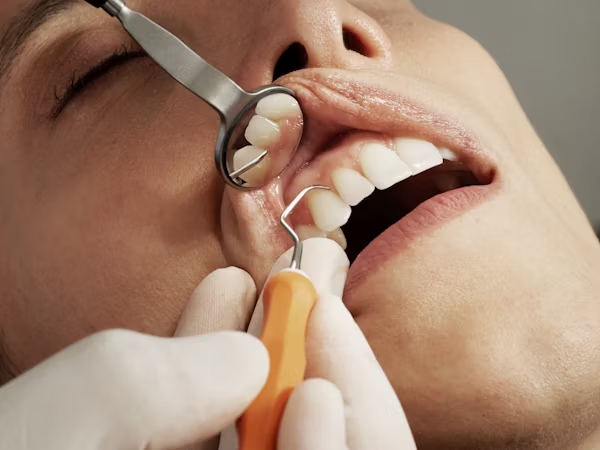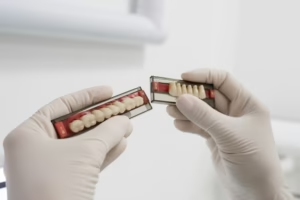Tartar removal is a key step in maintaining oral health. Learn how tartar forms, its potential damage, and how to deal with it properly to keep your smile healthy and bright.
What Is Tartar and How Does It Form?
Tartar is a hard layer that forms when bacteria interact with food debris and saliva, producing a sticky film known as plaque. If not cleaned regularly, plaque hardens over time into tartar, which cannot be removed by regular brushing and increases the risk of oral diseases.
Factors That Contribute to Tartar Formation
Several factors play a role in tartar buildup on teeth, including:
Poor Oral Hygiene
Neglecting to brush and floss regularly can lead to plaque buildup that hardens into tartar, which only a dentist can remove. Maintaining daily oral hygiene is key to preventing tartar accumulation.
Diet High in Sugars and Starches
Sugars and starches feed bacteria in the mouth, leading to acid production that erodes enamel and increases plaque buildup. Without cleaning, plaque eventually hardens into tartar.
Reduced Saliva Flow or Altered Composition
Saliva is a natural defense mechanism that helps cleanse the mouth. Low saliva production or changes in its composition (due to dehydration, certain diseases like diabetes, or specific medications) reduce its ability to resist plaque, speeding up tartar formation.
Benefits of Tartar Removal
Tartar removal is not just cosmetic, it’s essential for maintaining oral and dental health. Benefits include:
-
Healthier Gums and Disease Prevention
Tartar removal eliminates harmful buildup that causes gum inflammation, protecting against chronic gum disease and gum recession.
-
Lower Risk of Tooth Decay
Tartar provides a breeding ground for decay-causing bacteria. Removing it reduces the risk of cavities.
-
Fresher Breath
Tartar buildup often causes bad breath. Removing it helps eliminate odor-causing bacteria.
-
Whiter Teeth
Tartar is often yellow or brown and affects the appearance of teeth. Removal improves brightness and aesthetics.
-
Better Overall Oral Health
Keeping teeth free of tartar prevents severe problems like tooth loss or the need for advanced dental treatments in the future.
Risks of Tartar Cleaning
Despite its benefits, tartar removal may come with temporary side effects:
-
Tooth Sensitivity
Some patients may feel sensitivity to hot or cold foods after cleaning, usually due to exposed enamel or root surfaces. This often fades with time.
-
Gum Bleeding
Mild bleeding can occur, especially if gums were inflamed due to tartar buildup. Persistent bleeding should be evaluated by a dentist.
-
Exposed Roots
In cases of gum recession, cleaning may expose parts of the roots, leading to temporary discomfort.
Does Tartar Removal Weaken the Teeth?
Many believe that tartar removal weakens the teeth, but in reality, tartar itself is harmful. It causes gum disease, decay, and may even lead to tooth loss. Removing tartar eliminates these threats. While temporary sensitivity may occur due to exposed enamel that was covered by tartar, this usually subsides, and teeth return to normal.
Is Tartar Cleaning Painful?
Generally, tartar removal is not painful. Dentists use special tools to gently remove tartar from teeth and gums. However, patients with inflamed gums or excessive tartar buildup may experience some discomfort or sensitivity during the procedure.
How Is Tartar Removed?
Tartar cannot be removed completely with brushing or home tools, as it is a hardened buildup of plaque and minerals. A professional dental cleaning is necessary. Dentists use specialized tools and equipment to safely and effectively remove tartar.
Tartar Removal Process at the Dentist:
-
Initial Examination:
The dentist begins with a thorough assessment of your teeth and gums, identifying areas with heavy tartar buildup or inflammation.
-
Scaling with Special Tools:
Dentists use instruments to remove tartar from teeth surfaces and gum lines, sometimes employing laser technology for precision and comfort.
-
Polishing the Teeth:
After scaling, the dentist polishes the teeth to remove surface stains, leaving them smooth and shiny.
-
Fluoride Application:
A fluoride treatment is applied to strengthen enamel and protect against future decay.
How Many Sessions Are Needed?
The number of tartar removal sessions depends on the extent of buildup and gum health. Typically, one cleaning every six months is sufficient. However, in cases of excessive tartar or advanced gum disease, multiple sessions may be required.
Tartar Removal: Before and After
Before and after photos show a clear difference, stains disappear, gum health improves, and the overall appearance of teeth is significantly better. Regular cleanings help maintain these results long-term.

Post-Cleaning Tips
After a tartar removal session, it’s important to follow certain guidelines to maintain your oral health:
-
Avoid Colored Foods and Drinks for 24 Hours
Avoid coffee, tea, and other highly pigmented items to prevent immediate re-staining.
-
Use Fluoride Toothpaste
Fluoride strengthens enamel and protects teeth from decay and erosion after cleaning.
-
Floss Daily
Daily flossing removes food particles between teeth, preventing plaque and tartar from forming again.
-
Visit the Dentist Every 6 Months
Regular checkups help detect issues early and ensure consistent tartar control.
-
Avoid Smoking
Smoking damages gums and accelerates tartar buildup. Quitting helps preserve your dental health post-cleaning.
Restore Your Oral Health with Perfect Smile Clinics! We offer professional tartar removal using modern, science-backed techniques. Our expert team is dedicated to providing the highest standard of care. Book your appointment today and reclaim your confident smile!
Frequently Asked Questions (FAQs)
- Does tartar return after cleaning?
Yes, tartar can reaccumulate if proper oral hygiene is not maintained after cleaning.
- Do gums return to normal after tartar removal?
In most cases, gums heal and improve after tartar removal,





